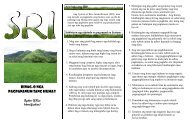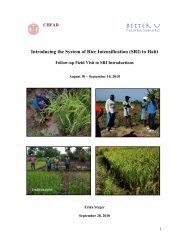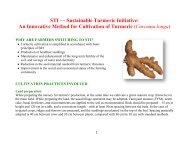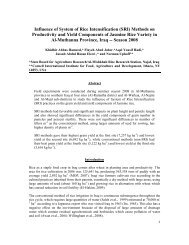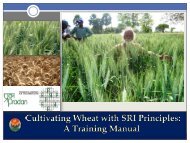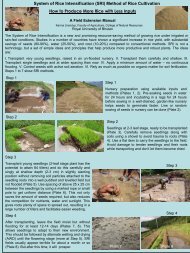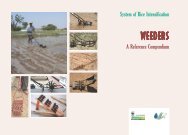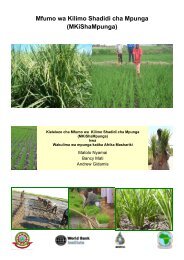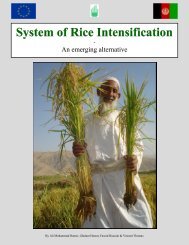EFFECT OF THE SYSTEM OF RICE INTENSIFICATION (SRI) ON ...
EFFECT OF THE SYSTEM OF RICE INTENSIFICATION (SRI) ON ...
EFFECT OF THE SYSTEM OF RICE INTENSIFICATION (SRI) ON ...
Create successful ePaper yourself
Turn your PDF publications into a flip-book with our unique Google optimized e-Paper software.
Rainfed rice in Cambodia is often grown with water levels ranging from 0 to 25 cm and in some<br />
situations after e.g. floods even more (Javier, 1997). During some periods of the cropping season<br />
for rainfed rice the soil might not be covered with water and aerobic conditions will be present due<br />
to little or no rainfall (Javier, 1997).<br />
Characteristic for rainfed lowland rice systems is typically that the possibility of drainage is often<br />
non-existing or only present to a small extent (Greenland, 1997) and the dependence on<br />
precipitation is enormous (Wade et al., 1999). Some of the main problems concerning rice yields<br />
from lowland rainfed rice systems are the time of rainfall, the amount of rainwater and low soil<br />
fertility (Pheav et al., 2005). As a consequence of the dependence on rainfall, water shortage is<br />
common (Seng et al., 1999). If the rainfall during the growing season is less than needed, this can<br />
lead to poor growth even if a given area receives enough precipitation throughout the year (Tsubo et<br />
al., 2007). As it is impossible to control the water level in the field for lowland rainfed rice<br />
systems, the rice crop will experience periods with total flooding and anaerobic conditions and<br />
other periods with drought which will have major influences on the availability of nutrients (Wade<br />
et al., 1998). Rice plants grown in this rice system are often tall (as submergence comes and goes<br />
very unpredictable) and have limited root growth and might not be able to take up enough water<br />
during drought periods (Wade et al., 1999). Due to the very changing water table weeds, insects<br />
and diseases are as well a major problem (Wade et al., 1999).<br />
5.3 <strong>SRI</strong> in Cambodia<br />
<strong>SRI</strong> was introduced to Cambodia in 2000 through various NGO based projects (Anthofer, 2004)<br />
and by 2003 approximately 10.000 farmers practised <strong>SRI</strong> and in 2004 50.000 farmers practised <strong>SRI</strong><br />
(Surridge, 2004). This number increased to 60.000 farmers in 2006 and in 2007 the number was<br />
approximately 80.000 farmers out of approximately 1.8 million rice farmers in Cambodia (Koma,<br />
2007). As a result of this development the Cambodian government has now adopted the <strong>SRI</strong><br />
methodology in their National Development Plan for 2006 to 2010 (Koma, 2007). CEDAC has<br />
been one of the leading agencies spreading and providing extension for <strong>SRI</strong> throughout Cambodia.<br />
29



